Artillery in Ireland: Athlone Castle, Baldonel, Birr, Bunratty Castle, Carlow, Cobh, Connolly Barracks, Custume Barracks, Drogheda, Duncannon, Dún Laoghaire Harbour, Ennis, and Galway
Artillery preserved in Ireland: Athlone Castle, Baldonel, Birr, Bunratty Castle, Carlow, Cobh, Connolly Barracks, Custume Barracks, Drogheda, Duncannon,
Dún Laoghaire Harbour, Ennis, and Galway
The aim of this website is to locate, identify and document every historical piece of artillery preserved in Ireland. Many contributors have assisted in the hunt for these guns to provide and update the data found on these web pages. Photos are by the author unless otherwise credited. Any errors found here are by the author, and any additions, corrections or amendments to this list of Guns and Artillery in Ireland would be most welcome and may be e-mailed to the author at [email protected].
The Artillery Corps (An Cór Airtléire), initially founded in 1924, is the artillery branch of the Irish Army. The Corps is charged with providing fire support to other sections of the Army. Since the Second World War, the Artillery Corps has been organised into separate Coastal Defence, Field Artillery and Air Defence Regiments. In the late 20th century, the Coastal Defence component was dissolved and integrated with the Field Artillery component. In 2013 the Air Defence regiment also ceased to operate as a separate component, and the Field Artillery regiments, known as Brigade Artillery Regiments, took over the Air Defence role.
Paddy Macky served in a couple of Irish Regiments and reported, "in the old days, we often referred to the 2nd Field Artillery Regiment as - 2 RAM (in English 2 FAR). In Irish (Gaelic), the "2nd Field Artillery Regiment" would be translated as "2ú Reisimint Airtleireachta Machaire", and so the same would be of the 1st, 3rd, 4th, 5th Regiments etc."
Today the Artillery Corps comprises the Artillery School, located in the Defence Forces Training Centre (DFTC) in Curragh Camp, and two Brigade Artillery Regiments (one for each of the two Brigades of the army), located in Collins Barracks, Cork (1 BAR) and Custume Barracks, Athlone (2 BAR).
Athlone Castle, Athlone, Westmeath, Ireland

(Borvan53 Photo)
The earliest recorded “castle” of Athlone was a wooden structure built in 1129, by King Tairrdelbach Ua Conchobair of Connacht, possibly on the site of the present castle. The stone castle which survives today dates from the year 1210 and was built for King John by his Irish Justiciar, Bishop John de Gray of Norwich. It was built to defend the crossing point of the river at Athlone and to provide a bridgehead to facilitate the Norman advance into Connaught.

(Author Photo)
The castle of 1210 was a free standing polygonal tower built on a newly built (or existing) ‘motte’ or man-made hill. This tower, though greatly altered, can still be seen as the central keep or ‘donjon’ of the castle today. At the time the castle was built the Shannon, as it passed through Athlone, was very different from today. It is likely that in the early days of its existence the castle enjoyed the protection of a fosse or moat.
The castle was greatly fortified in the late 13th century (ca 1276) when the original ‘motte’ was surrounded with a curtain wall with three-quarter round towers (or drum towers) at the corner. These features, again greatly rebuilt, still survive today. The castle was reconstructed by Sir William Brabazon (Lord Justice of Ireland) in 1547.
The external walls and towers came under heavy fire during the Sieges of Athlone in 1690 and 1691, and they were later destroyed when lightning struck the castle in 1697. The castle as we view it today shows signs of extensive remodelling during the Napoleonic era when it was modernised and adapted for artillery. Today the squat drum towers are somewhat reminiscent of the Martello towers (again of the Napoleonic era) which are found around Dublin.
The large scale Ordnance survey map of 1874 named some of the features which were then extant on the castle. These included the Officers’ quarters & soldiers’ quarters; master gunners’ quarters; guard house; ablutions room; cook house; kitchen; guard house and draw bridge. The officers’ quarters and soldiers’ quarters were located in the five-bay, two-storey barrack building which overlooks Main Street. This late Georgian building dates to ca 1810.

(Author Photo)
The Castle has many interesting features including the shape of the ‘sally gate’ in the wall of the castle overlooking the Shannon; a bow loop from the era when the castle was protected by archers, in the wall facing into Castle Street as well as gun-embrasures and pistol loops on the walls protecting the entrance ramp. One important feature which disappeared in the 20th century was the drawbridge which survived until the 1940s. The castle was taken over by the Irish Army in 1922 and continued as a military installation until it was transferred to the Office of Public Works in 1970.
The Keep of the Castle is a National Monument. The castle which had been part of the defences of Athlone for 750 years became the home of a museum run by the Old Athlone Society in 1966 and of a modern visitor centre developed by Athlone Urban District Council in 1991. Athlone Castle is pivotal to the understanding of the development of the town of Athlone, linking the modern Athlone with its Norman founders.

(Author Photo)
Cast Iron 24-pounder Armstrong pattern Smoothbore Muzzleloading Gun, heavily corroded, but with remains of a Royal cypher (King George 2 or 3), visible on the barrel, No. 1 of 2.

(Author Photo)
Cast Iron 24-pounder Armstrong pattern Smoothbore Muzzleloading Gun, heavily corroded, but with remains of a Royal cypher (King George 2 or 3) visible on the barrel, No. 2 of 2. Athlone Castle was first fitted out as an artillery platform shortly after 1800. At that time it mounted eleven 6-pounder guns, although heavier guns were subsequently installed. This gun is an 18th century 24-pounder. The Royal monogram of King George is visible on the barrel (GR). The embrasure, through which the gun barrel is projecting is brick-lined to soften the impact of hostile fire and to reduce the danger to the gunners from stone splinters.


(Author Photos)
Cast Iron 10-inch 16-cwt Smoothbore Muzzleloading Land Service Mortar, No. 1 of 2.


(Author Photos)
Cast Iron 10-inch 16-cwt Smoothbore Muzzleloading Land Service Mortar, No. 2 of 2.
Athlone, Custume Barracks, Ireland
Custume Barracks, named after Sergeant Custume who defended the bridge from the forces of King William III during the Siege of Athlone, were completed in 1691. The barracks were taken over by forces of the Irish Free State in 1922 and served as the headquarters of 4th Western Brigade until the brigade was disbanded and is now part of 2 Brigade which is headquartered from Cathal Brugha Barracks in Dublin. The barracks remains the home of 6th Infantry Battalion as the lead unit, and 2nd Brigade Artillery Regiment and detachments of 2 Engineer Company and the Medical Corps.

(Colin Stone Photos)
French 75-mm Field Gun, aka Canon de 75 Modèle 1897, on the parade square, Custume Barracks.
The French 75 mm field gun is a quick-firing field artillery piece adopted in March 1898. Its official French designation was: Matériel de 75mm Mle 1897. It was commonly known as the French 75, simply the 75 and Soixante-Quinze (seventy-five). The French 75 was designed as an anti-personnel weapon system for delivering large volumes of time-fused shrapnel shells on enemy troops advancing in the open. After 1915 and the onset of trench warfare, other types of battlefield missions demanding impact-detonated high-explosive shells prevailed. By 1918 the 75s became the main agents of delivery for toxic gas shells. The 75s also became widely used as truck mounted anti-aircraft artillery. They were also the main armament of the Saint-Chamond tank in 1918.
The French 75 is widely regarded as the first modern artillery piece. It was the first field gun to include a hydro-pneumatic recoil mechanism, which kept the gun's trail and wheels perfectly still during the firing sequence. Since it did not need to be re-aimed after each shot, the crew could reload and fire as soon as the barrel returned to its resting position. In typical use, the French 75 could deliver fifteen rounds per minute on its target, either shrapnel or melinite high-explosive, out to a range of about 8,500 m (5.3 mi) away. Its firing rate could even reach close to 30 rounds per minute, albeit only for a very short time and with a highly experienced crew.
At the beginning of the First World War, in August 1914, the French Army had about 4,000 of these field guns in service. By the end of the war about 12,000 had been produced. It was also in service with the American Expeditionary Forces (AEF), which had been supplied with about 2,000 French 75 field guns. Several thousand were still in use in the French Army at the beginning of the Second Word War, updated with new wheels and tires to allow towing by trucks rather than by horses. The French 75 set the pattern for almost all early-20th century field pieces, with guns of mostly 75 mm forming the basis of many field artillery units into the early stages of the Second World War.
Britain acquired a number of "autocanon de 75-mm mle 1913" anti-aircraft guns in 1915, as a stopgap measure while it developed its own anti-aircraft alternatives. These AA guns were used in the defence of Britain, usually mounted on de Dion motor lorries using the French mounting which the British referred to as the "Breech Trunnion". Britain also purchased a number of the standard 75-mm guns and adapted them for AA use using a Coventry Orndance Works mounting, the "Centre Trunnion". At the Armistice there were 29 guns in service in Britain.
In June 1940, with many British field guns lost in the Battleof France, 895 M1897 field guns and a million rounds of ammunition were purchased from the US Army. The basic, unmodified gun was known in British service as "Ordnance, QF, 75mm Mk 1", although many of the guns were issued to units on converted or updated mountings. They were operated by field artillery and anti-tank units. Some of the guns had their wheels and part of their carriages cut away so that they could be mounted on a pedestal called a "Mounting, 75mm Mk 1". These weapons were employed as light coastal artillery and were not declared obsolete until March 1945.
During the Second World War, the British also received the American half-track M3 Gun Motor Carriage under Lend Lease terms and used these in Italy and Northern Europe until the end of the war as fire support vehicles in Armoured Car Regiments. (Wikipedia)

(Library and Archives Canada Photo, MIKAN No. 3607690)
Canadian Army T30 Howitzer Motor Carriage halftracks equipped with a 75-mm M1897A4 howitzer, aka "French 75" in Italy ca 1944.


(Colin Stone Photos)
Ordnance QF 18-pounder Mk. IV field gun mounted on a Mk. V carriage. The 18-pounder was the standard British Empire field gun of the First World War-era, and was produced in large numbers. It was used by British Forces in all the main theatres, and by British troops in Russia in 1919 . Its calibre (84-mm) and shell weight were greater than those of the equivalent field guns in French (75-mm) and German (7.7-cm) service. The first versions were introduced in 1904. It was generally horse drawn until mechanisation in the 1930s. Later versions remained in service with British forces until early 1942.

(IWM Photo, 4700-101)
A Morris 6x4 Field Artillery Tractor of 96 Field Battery, Royal Artillery, tows one of the unit's Ordnance QF 18-pounder Mk. IV field guns (mounted on a Mk. V carriage) and limber over sandy terrain in 1938. Note the tracks fitted to the Morris tractor to give more purchase on the sand.
Baldonnel, Casement Aerodrome, County Dublin, Ireland
Baldonel is chiefly known as the location of the headquarters of the Irish Air Corps (Irish Air Defence Forces) at Casement Aerodrome, Baldonnel, which has been in operation for over 90 years in the locality, first as a RFC then a RAF aerodrome until the creation of the Irish Free State in 1922, when the Irish Air Corps (IAC) took command of the field.
A Brief History of 2 Air Defence Battery, (Excerpt, Comdt John O’Brien, September 1989)
“The origin of the 2 Air Defence Battery (FCA), previously designated 2 Anti-Aircraft Battery up to 1986, lies in the 1959 re-organisation of the Permanent Defence Force and the Reserve Defence Forces. The popular title given to this re-organisation was “integration”, and this succinctly describes the intention and effect of bringing the Forces together under common command and organisation. The newly formed 2 Battery (Dublin) and its comrade unit, the 3 Battery (Limerick) came together with the 1 Battery (PDF, Kildare) newly constituted 1 Anti-Aircraft Regiment with Headquarters in Magee Barracks, Kildare. The location of the batteries in Dublin and Limerick were influenced by the defence requirements of the major airfields. The 4 Battery (Cork) was not formed until 1979, following the disbandment of the Coast Defence Artillery. Under a later re-organisation of the Forces, most units reverted to structures somewhat comparable to the pre-1959 organisation. The 1 Air Defence Regiment, however, remains fully integrated.”
“The battery came into existence in October 1959 when ten officers selected from FCA infantry units in and around Dublin came together to the new unit, under Lt Paul Holahan who had been given command of the fledging team. Volunteers, NCOs and men were sought from other Dublin unts to provide a nucleus of experience and skill before general recruitment was opened. Amongst those volunteers were Cpl Michael Flood, now Battery Commander, and Comdt Larry Holmes who was Battery Adjutant.”
“In the initial years, firing practice was held during annual training camp, but for a period of ten years until the aerial target was acquired firing generally took place on a weekend in September. Between 1969 and 1977, the varied the locations of its annual camp. Kilkenny, Limerick, Lahinch, Duncannon and Ballincollig, all received the battery most hospitality and we were most thankful to the units and personnel who facilitated this enjoyable nomadic interlude.”
“In the late 1970s a decision was taken that the batteries should continue as an entity for the Regiment’s annual firing practice. From 1979 to 1981, the battery’s annual camp extended to three weeks. Since 1983, the annual camp has been confined to one week and this ensures a hectic programme to be carried out in Gormanston with the three batteries to fire. It is a tribute to all concerned, particularly Regimental Headquarters that in...1989, time was found to mount a formal demonstration of weapons and mementos of the regiment and its predecessors.” (The Artillery Club Newsletter, 13 Sep 2019)
.avif)
.avif)
.avif)
.avif)
(Colin Stone Photos)
Bofors 40-mm L/60 QF Light Anti-Aircraft Gun, mounted on a wheeled gun carriage. The Bofors 40-mm gun is an anti-aircraft autocannon designed in the 1930s by the Swedish arms manufacturer AB Bofors. It was one of the most popular medium-weight anti-aircraft systems during the Second World War, and was used by most of the western Allies as well some captured systems being used by the Axis powers. A small number of these weapons remain in service to this day.
Bandon, County Cork
.webp)
(Edward Bourke Photo)
Bronze SBML cannon from the wreck of the Santa Ana Maria, in private hand in Bandon. The Santa Ana Maria was built in 1628, and was running silver from the New World to Spain when she was captured by a Dutch privateer, Piet Hayn. He planned to sail her back to Holland and strip her of most of her cargo and some of her guns. But British privateers subsequently captured her and were on their way to Bristol when the ship caught fire and sank off the West Cork coast. The remains of the galleon were discovered in the 1970s and it is now a protected site. However, while some of its guns were recovered a number still remain on the seabed. It is unclear whether any the silver bullion remains on the wreck. (Connie Kelleher)
Bantry Bay, Bantry House, Ireland (preserved artillery in this location is listed on a separate page on this web site)
Birr, County Offaly

(Alan Wright Photo)
Cast Iron Smoothbore Muzzleloading Sevastopol Cannon, (Serial No. 20955) on the left trunnion, 18 - ? , Serial No. 1827T on right trunnion. This cannon is a Russian war trophy captured in the Crimean War (1853-1856), mounted on a wood wheeled carriage in front of the Birr town hall.
Cast Iron Smoothbore Muzzleloading Gun in front of Birr castle, mounted on a wood stand.
Bunratty Castle, County Clare, Ireland
There are five Cast Iron Smoothbore Muzzleloading Guns preserved inside the grounds of Bunratty Castle, a large 15th century tower house in County Clare. It is located in the centre of Bunratty village, by the N18 road between Limerick and Ennis, near Shannon Town and its airport.

(Chris Light Photo)

(Nils E. Photo)
Cast Iron Smoothbore Muzzleloading Gun mounted on a wood naval gun carriage, No. 1 of 5 in Bunratty Castle.
Cast Iron Smoothbore Muzzleloading Gun mounted on a wood naval gun carriage, No. 2 of 5 in Bunratty Castle.
Cast Iron Smoothbore Muzzleloading Gun mounted on a wood naval gun carriage, No. 3 of 5 in Bunratty Castle.
Cast Iron Smoothbore Muzzleloading Gun mounted on a wood naval gun carriage, No. 4 of 5 in Bunratty Castle.
Cast Iron Smoothbore Muzzleloading Gun mounted on a wood naval gun carriage, No. 5 of 5 in Bunratty Castle.
Carlow, County Carlow

(Alan Wright Photo)
Cast Iron Smoothbore Muzzleloading Gun mounted on an iron garrison gun carriage in front of the Carlow County courthouse.
Cobh, Ireland



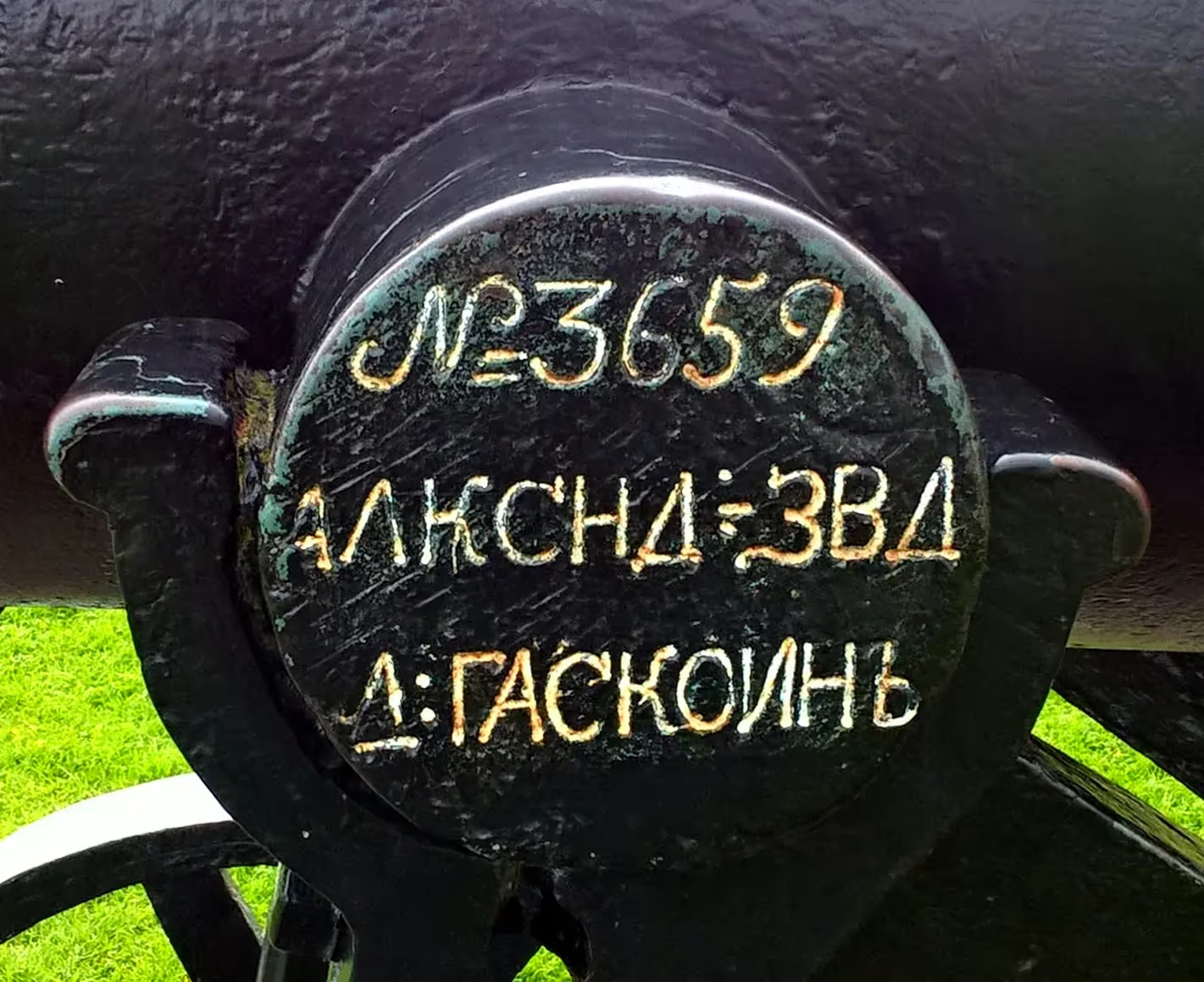


(Colin Stone Photos)

(Bruce S Photo)

(Jarda315 Photo)
Russian Cast Iron 24-pounder Smoothbore Muzzleloading Gun (Serial No. 3659) on the left trunnion, possibly by Foullon at Alexandrovski, with double-headed Eagle on the barrel, mounted on an iron garrison gun carriage. No. 93 is marked below the vent. This cannon is a war trophy from the Crimean War (1853-1856). A number of Irish regiments fought in the Crimean War. The British seized some 1,500 iron SBML guns and hundreds of bronze cannon at the end of the Crimean War in 1856. Shortly afterwards, guns captured at the great Russian Naval base of Sevastopol in the Crimea were offered for display in towns and cities throughout the UK and the British Empire, and many are still to be found where they were set up as war memorials in 1856. This gun was found in the mighty fortress of Sevastopol. No. 1 of 2 facing the Cobh harbour near Westbourne Place. Munster.


(Bruce S Photo)
Blomefield Cast Iron 24-pounder Smoothbore Muzzleloading Gun, weight unknown, (WCo) Walker & Company of Rotherham, Yorkshire, England on the left trunnion, (Serial No. 33) on the right trunnion, mounted on a 24-pounder iron garrison carriage, No. 2 of 2 Guns facing the harbour.
Cork, Ireland
Camden, Fort Meagher, Cross Haven, Cork Harbour

(Kieran Sheehan Photo)
Cast Iron possible 12-pounder Smoothbore Muzzleloading Gun, weight unknown, SOLID on the left trunnion, King George 2 cypher, 2, on the barrel, mounted on a wood gun carriage, Camden Fort Meagher, Cross Haven, Cork Harbour.

(Artillery Club Ireland Photo)
Camden Fort Meagher, Cross Haven, Cork Harbour.
Camden Fort Meagher is an example of a classical Coast Defence Artillery installation. For almost 400 years, Camden Fort Meagher, played a key role as a strong strategic position for the defence of Ireland, the west coast of England and Wales. 65% of the fort is located underground in a labyrinth of tunnels and chambers. Camden Fort Meagher is a Coast Defence Artillery fortification defending the mouth of Cork harbour together with Fort Mitchell (Spike Island), Fort Davis (Whitegate) and Fort Templebreedy.

(Artillery Club Ireland image)
Map of Camden Fort Meagher, 1896. Although constructed in the 16th century, the current fort dates from the 1860s. The fort was one of only 8 installations worldwide to house the world’s first guided missile “The Brennan Torpedo”. Originally named Fort Camden, it was handed over to the Defence Forces in 1938 along with other Treaty Ports, such as Fort Dunree. Remamed Fort Meagher, it remained as a military installation until it was handed over to Cork County Council in 1989. Extensive restoration work is continuing with financial and logistical support provided by Cork County Council and other stakeholders. The renovation benefits from the support of Employment schemes from the Department of Social Protection and the commitment of over 45 dedicated volunteers and staff. Currently, the fort contains a number of exhibition rooms such as: the Irish Story, the English Story, Ground Zero 360, Naval Exhibition, First World War Exhibition, Rescue Camden Story, and the Gunners Room.
The underground tunnels were used to access munitions storage areas and used for safe passage for the defending personnel. Currently, 20% approx of the tunnels are accessible to the public. The vaulted ceiling magazine, set deep underground, was used to store munitions and gunpowder. The fort is a prime location to watch ships passing through Cork Harbour, the second largest natural harbour in the world.
Cork, Spike Island, Fort Mitchell, Ireland (preserved artillery in this location is listed on a separate page on this web site)
Cork, Haulbowline Island, Ireland (preserved artillery in this location is listed on a separate page on this web site)
Corofin, County Clare, O'Dea Castle

(Bruce S Photo)
Cast Iron possible 12-pounder Smoothbore Muzzleloading Gun, mounted on a wood stand, guarding O'Dea Castle
Devoy Barracks, Naas, County Kildare
The barracks, which were originally known as Naas Barracks, were built for local militia units in 1813. They became the depot of the Royal Dublin Fusiliers when that regiment was formed in 1881. The Royal Dublin Fusiliers were disbanded at the time of Irish Independence in 1922. The barracks were secured by the forces of the Irish Free State in February 1922. The barracks, which were renamed Devoy Barracks after John Devoy, an Irish republican, closed in 1928 and the site was subsequently used for a variety of industrial uses. The Irish Army Apprentice School was established on the site in 1956 but closed in 1998 when the barracks were finally decommissioned.

(Colin Stone Photos)
Ordnance QF 25-pounder field gun.
Dublin (preserved artillery in this location is listed on a separate page on this web site)
Drogheda

(Alan Wright Photo)
.webp)
(William Murphy Photo)
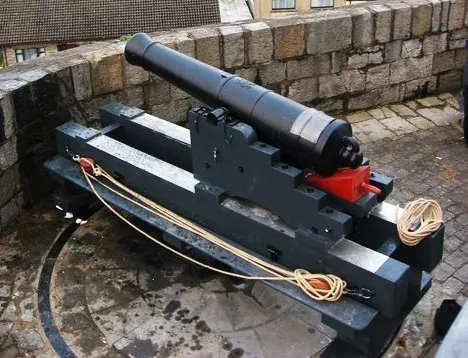
(Kieran Campbell Photo)
Blomefield Cast Iron 24-pounder Smoothbore Muzzleloading Gun, weight unknown, (WCo) Walker & Company of Rotherham, Yorkshire, England on the left trunnion, (Serial No. unknown) on the right trunnion, mounted on a long wood traversing carriage, Millmount Museum.

(Alan Wright Photo)

(Alan Wright Photo)

(Alan Wright Photo)

(Alan Wright Photo)
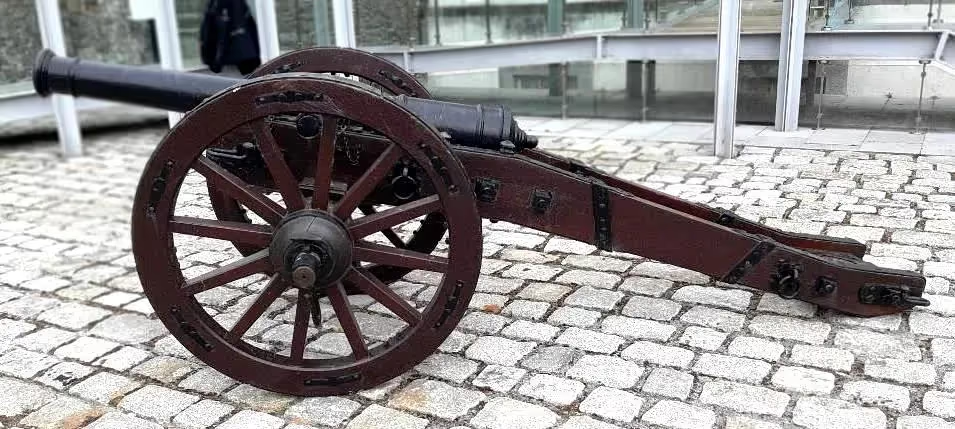
(Alan Wright Photos)
Three cast iron 4-pounder smoothbore muzzleloading French Cannon, two, mounted on wheeled wood gun carriages with limber, and one unmounted, preserved on the grounds of the Battle of the Boyne Visitor Centre. The Long barrel version; barrel length: 2.58m; weight of gun and carriage: 1200 kgs. It was transported by attaching the gun to a two-wheel limber, drawn by 3/4 horses in line. These cannon fired solid 4.3 lb iron cannonballs and sometimes canisters of musket balls; maximum range: 2500m; effective point-blank range: 500m; best rate of fire: 20 shots per hour; working life: 1200 shots; gun-crew: 8. 12 iron 4-pounders brought from France and deployed on Jacobite side at the Boyne.
Cast iron 3-pounder smoothbore muzzleloading Dutch Falcon Cannon. The barrel length: 2.2m; weight of gun and carriage: 600 kgs. This cannon was transported by attaching the gun to a two-wheel limber, drawn by 2/3 horses in line. Fired solid 3 lb iron cannonballs and sometimes canisters of musket balls; maximum range: 2500m; effective point-blank range: 450m; best rate of fire: 20 shots per hour; working life: bronze indefinite, iron 1200 shots; gun-crew: 8. 12 iron 3-pounders sent to Ireland in 1689 were probably still in service with the Williamite artillery at the Boyne; the Dutch artillery probably included 3-pounders which were standard regimental cannon in Holland.
Bronze 6-pounder smoothbore muzzleloading English Saker Cannon. The barrel length: 2.9m; weight of gun and carriage: 1300 kgs. It was transported by attaching the gun to a two-wheel limber, drawn by 3/4 horses in line. It fired solid 6 lb iron cannonballs and sometimes canisters of musket balls; maximum range: 4000m; effective point-blank range: 500m; best rate of fire: 20 shots per hour; working life: bronze indefinite, iron 1200 shots; gun-crew: 8. 4 bronze English sakers sent to Ireland in 1689 were probably still in service with the Williamite artillery at the Boyne.
Cast iron smoothbore muzzleloading Dutch Field Mortar. This a short barrelled weapon, fired at 45 Degree angle; generally deployed with heavy artillery in siege warfare; a light version, or howitzer, had been developed in Holland. It was transported on carts, from which the gun was lifted onto the ground for use. It fired large solid shot, stones, bombs and incendiaries; maximum range 1,000m. 5 heavy mortars sent to Ireland in 1689; at the Boyne, the Williamites deployed a battery of Dutch light mortars/howitzers.
The Visitor Centre is housed in the restored 18th century Oldbridge House on the banks of the River Boyne, and provides in-depth insight into the battle between King William III and his father-in-law King James II on 1 July 1690. The kings were rival claimants to the English, Scottish and Irish thrones. Protestant King William (of Orange) had deposed Catholic King James in 1688. James went to Ireland where he rallied his mostly Catholic army, making a stand on the banks of the Boyne outside Drogheda. The Battle of the Boyne was the largest ever assembly of troops on an Irish battlefield. A walk through the forest leads to King Williams’s Glen, where 36,000 troops set up camp during the war before launching a surprise attack on the troops of King James II. The battle resulted in a victory for William. Although the Williamite War in Ireland continued until October 1691, James fled to France after the Boyne, and never returned.
The Williamite artillery train comprised more than thirty Dutch and English field guns and ‘field mortars’ (perhaps howitzers). The Jacobite train consisted of twelve French 4-pounders and four cannon sourced in Ireland. On the eve of the battle, in an exchange of artillery fire, King William was slightly wounded in the shoulder. During the battle, the Williamite cannon bombarded the Jacobite soldieries as they moved upstream. The ten Jacobite cannon at Oldbridge were withdrawn to safety before the Williamite attack. The six guns on their left wing checked the Williamite pursuit at Duleek. Only one was lost.

(Wikipedia)
Painting: Battle of the Boyne between James II and William III, 11 July 1690, by Jan van Huchtenburg, Rijksmuseum Amsterdam.
Article from Weapons and Warfare: Battle of the Boyne
fter James II of the House of Stuart was forced off the throne of England in the Glorious Revolution of 1688, he sought to regain his fortunes in Ireland. James went into exile in France in January 1689, as a guest of Louis XIV, the king of France. After his Protestant daughter Mary and her husband, William of Orange, stadtholder of Holland or the Netherlands, were secure in England, Scotland and Ireland were still largely favorable to the Stuarts. In Ireland, the Catholic population favored James II, who was a Roman Catholic. Regardless of the regime change in London, among the Irish Catholics, James II was still “Righ Seamus” (King James).
Louis XIV firmly supported James when he landed in Ireland at Kinsale in March 1689. Not only did Louis XIV see this as a real “second front” in his struggle with William, but he also seems to have been personally committed to James’s cause. In England William and Mary had to support the Protestant succession to the throne, but the Irish Parliament James summoned came out for freedom of conscience.
One of the causes of the Glorious Revolution was that James was building an Irish army in Ireland to offset the forces in England that were more under the control of the Protestant Parliament. Richard Talbot, the earl of Tyrconnell, had been charged in 1685 to form the Irish troops and ruled Ireland in the name of James as his lord-lieutenant.
Unfortunately, not enough authority was given to Patrick Sarsfield, a natural leader who inspired his troops quite beyond what Tyrconnell could do. This seems to have aroused Tyrconnell’s jealousy, which undermined James’s hopes of using Ireland as a launching point to regain England.
In August 1689, William sent an army across the Irish Sea to face James in Ireland. It was commanded by Friedrich Hermann, the first duke of Schomberg. Like Sarsfield, who had fought for the French in the Dutch War of 1672, Schomberg was a veteran of the wars in Europe. Ironically, Schomberg had fought in the French Army as well, but when Louis XIV revoked in 1685 the Edict of Nantes, giving toleration to French Protestants (Huguenots), Schomberg left French service to become commanding general of the margrave of Brandenburg, Frederick William. In 1688, he accompanied William to England, and was there made the duke of Schomberg. However, his military record in Ireland proved disappointing to William.
William landed at Belfast on June 14, 1690. Having secured Ulster, the traditional Protestant stronghold of northern Ireland, William moved south toward Dublin, the heart of the Catholic south that supported James. On the strategic defensive now, James decided to meet William along the line of the Boyne River, using it as a natural defensive rampart against William’s southern advance. William’s army numbered about 36,000 men, while James could muster only about 25,000 men. Moreover, William’s army was given a strong boost by his Dutch Guards, veterans of the years of warfare against Louis XIV. On July 1, the two armies met along the banks of the Boyne. William decided to force a crossing of the river about four miles from the city of Drogheda.
Immediately, the strategic deficiencies of James’s army showed themselves when William was able to open the battle with an artillery barrage from a cannon he took with him from England. James had no such strength in artillery. William, Schomberg, and other military advisers had decided to cross the Boyne at the village of Oldbridge, where there was some natural shelter for his troops. At the same time, part of the Williamite army made a feint north up the river, hoping to force a response from James to protect his line of retreat. In the morning of July 1, the troops began their march under Schomberg’s son, Charles de Schomberg. The fighting under Schomberg, while not decisive, succeeded in tying down some 6,000 of James’s soldiers.
Four hours after the combat had started in the north, William’s troops under Schomberg began the main crossing at Oldbridge, with the Dutch Guards bearing the brunt of the offensive. In what would become one of the most brutal battles of the era, the Dutch Guards, supported by regiments of French Huguenots, forced a passage of the Boyne. They ran into stiff opposition from the Irish Guards when the earl of Tyrconnell led a charge of his cavalry down the slope of the river, adding their weight to the contest between the Dutch and Huguenots, and the Irish Guards backed by other Irish regiments.
For two hours, a savage fight followed, with neither side gaining the upper hand. The battle was so intense that the elder Schomberg spurred his horse into the thick of the fight to urge on the Dutch. In the heat of the moment, he had failed to put on his breast plate and was mortally wounded by Tyrconnell’s Irish horsemen. With the bulk of James’s army now tied down in the north or at Oldsbridge, another Williamite column had crossed the Boyne to the south. At noon, William himself crossed the Boyne at Drybridge, a deep crossing spot. Meanwhile, James kept his attention riveted on the fighting at Oldbridge. With the appearance of William’s fresh troops, James’s Irish soldiers, who had been fighting furiously for two hours at Oldbridge, became seriously outnumbered. James and Tyrconnell began a withdrawal after almost three hours of continuous combat, covered by the sabers of Tyrconnell’s Irish cavalry.
James’s army made its retreat to Duleek, where the parts of the army that had confronted the young Schomberg were united with those from the main part of the battle at Oldbridge. Although William attempted a pursuit, he was stopped by the Irish. Although the war would continue until the Irish surrender at the Treaty of Limerick in October 1691, James II would never be able to recover the strategic initiative he had lost on the banks of the Boyne River in July 1690.
Further reading: Hayes-McCoy, G. A. Irish Battles: A Military History of Ireland. New York: Barnes and Noble, 1997; Hennessy, Maurice N. The Wild Geese: The Irish Soldier in Exile. London: Sidgwick and Jackson, 1973; O’Callaghan, John Cornelius. History of the Irish Brigades in the Service of France. Shannon: Irish University Press, 1969.
Duncannon, County Wexford, Ireland
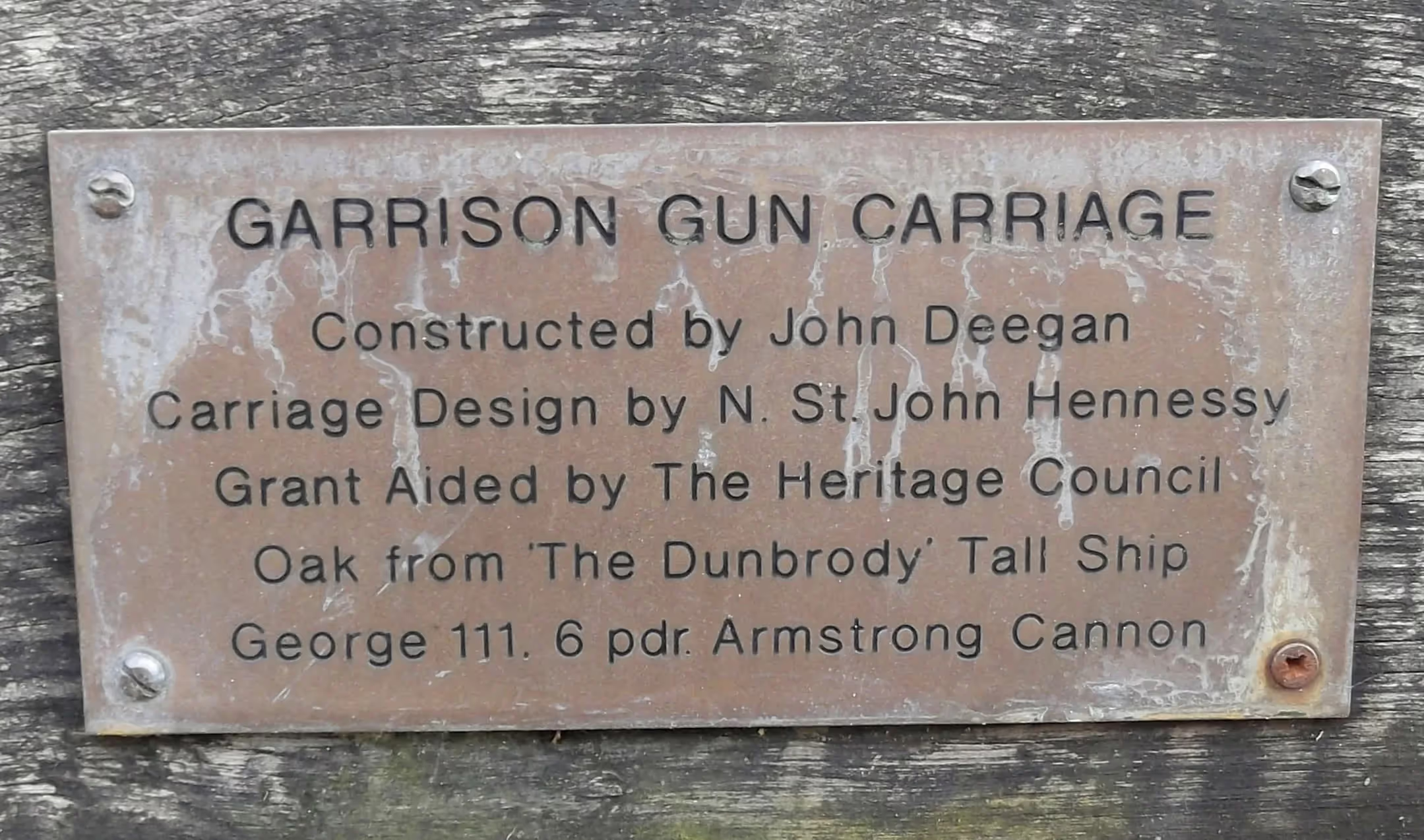
(Colin Stone Photo)
Cast Iron 6-pounder Smoothbore Muzzleloading Gun mounted on a naval gun carriage, No. 1 of 2.
Cast Iron 6-pounder Smoothbore Muzzleloading Gun mounted on a naval gun carriage, No. 2 of 2.

(Colin Stone Photo)
Cast Iron 6-pounder Smoothbore Muzzleloading Gun unmounted, No. 1 and No. 2 of 3.

(Colin Stone Photos)
Cast Iron 6-pounder Smoothbore Muzzleloading Gun unmounted, No. 3 of 3.
Dún Laoghaire Harbour

(Ian Cundy Photo)




(Nick Reed Photos)


(Aidan Keenan Photos)

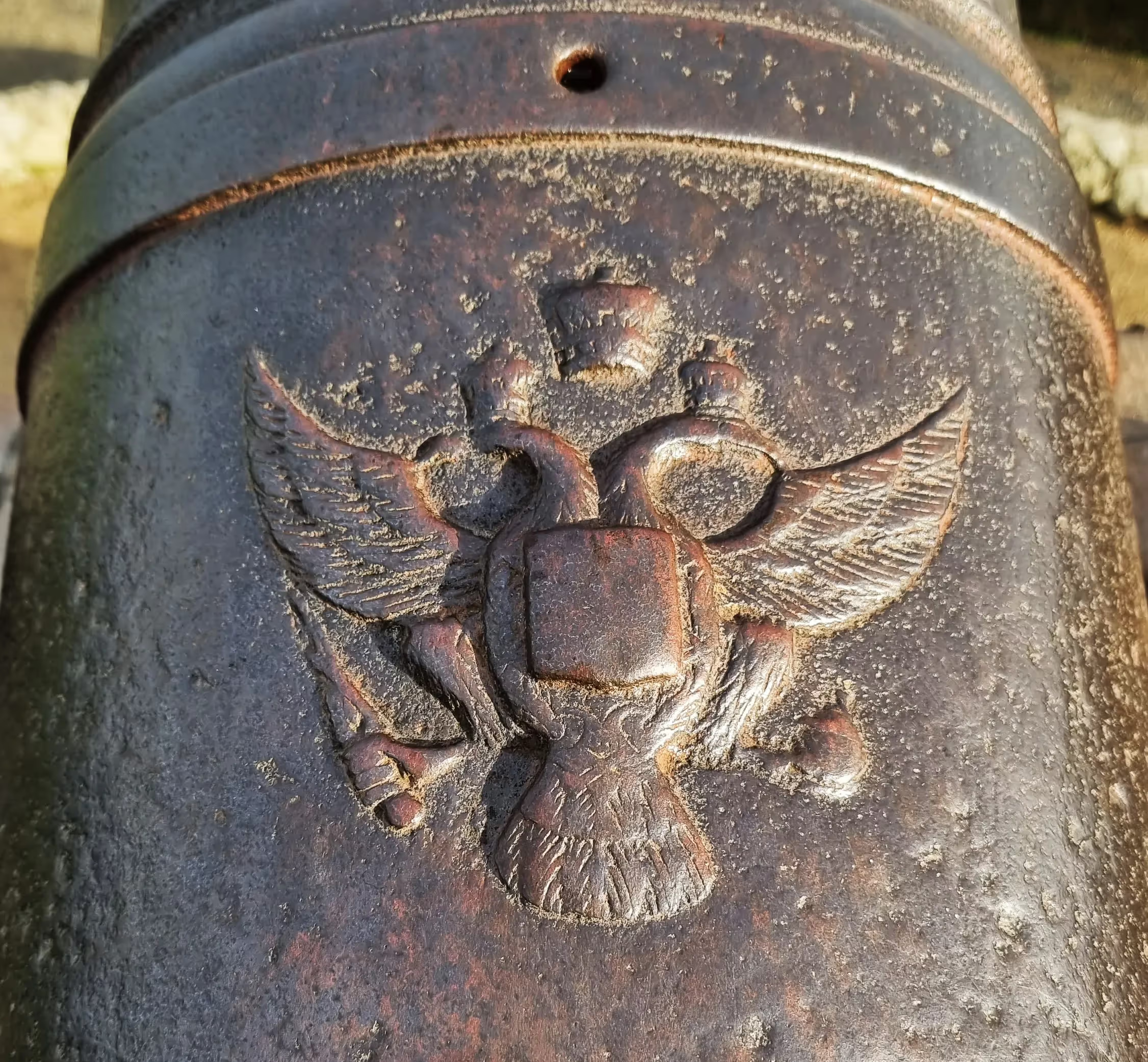



(Huw Roberts Photos)
Russian Cast Iron 24-pounder Smoothbore Muzzleloading cannon mounted on a wood naval gun carriage. P, No. 84 above the knob on the base of the breech. This cannon is one of nearly 3,000 guns that were captured during the Crimean War (1853-1856). Most of them from the siege of Sebastopol. Due to public discontent with the management of the war it is suspected that these numbers were exaggerated in order to show why the siege took so long. In the Treaty of Paris, which ended the war, it was agreed that each of the victors would receive cannons from the Russians as trophies of their victory. Some of these Russian cannon were put on display in towns throughout Britain and Ireland. In Ireland over 20 towns are believed to have applied for and received a Russian cannon for display. The double eagle and crown of the Romanov family crest on the cannon is still visible on some of them today.
Ennis, County Clare


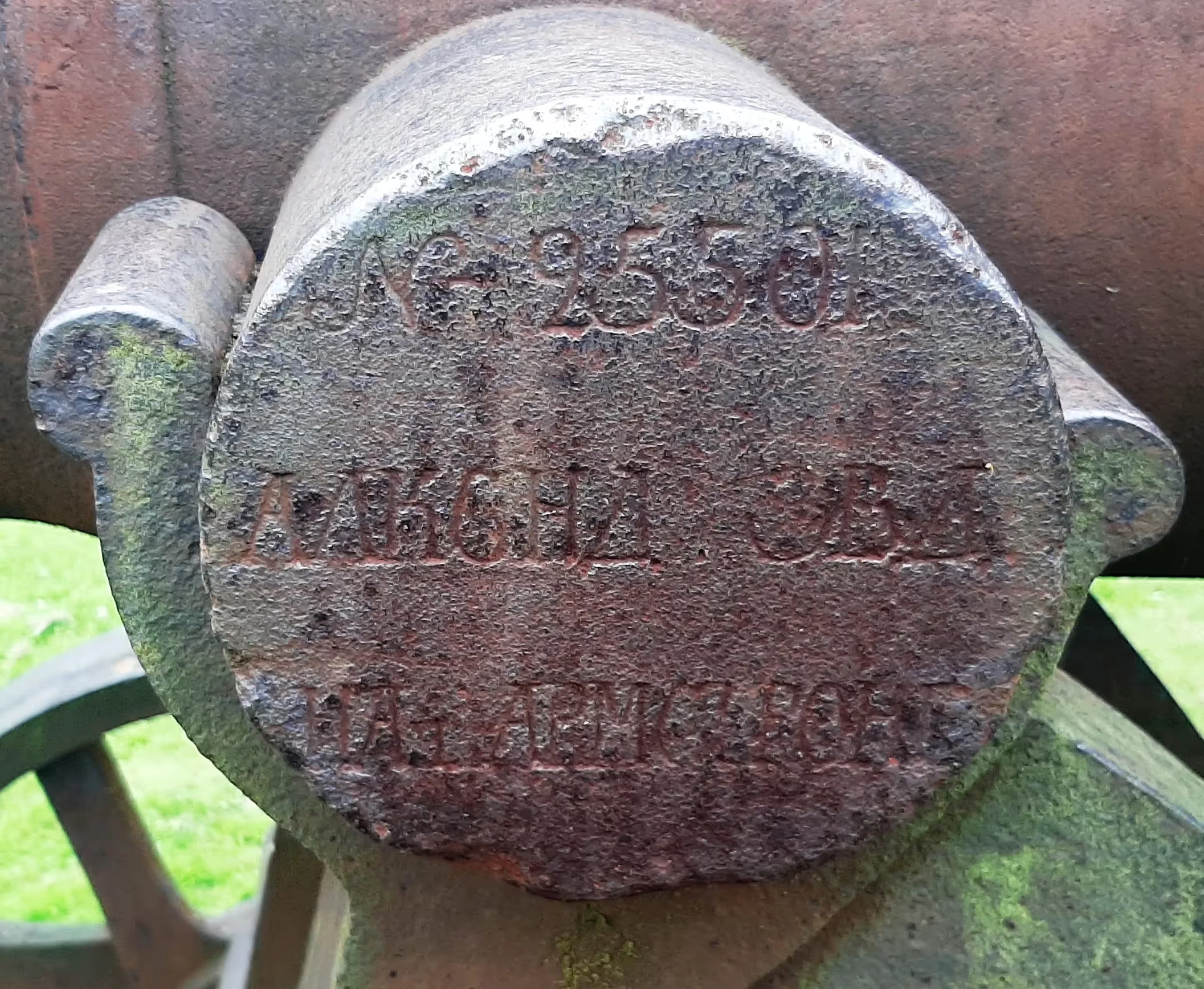

(Alan Wright Photos)
Cast Iron Smoothbore Muzzleloading Sevastopol Cannon, (Serial No. 2558) on the left trunnion, 36 - ? symbol, corroded data on the right trunnion. This cannon is a Russian war trophy captured in the Crimean War (1853-1856), mounted on an iron carrison carriage in front of the Ennis courthouse. In January of 1858, Mr. J.D. Fitzgerald, Attorney General of Ireland and MP of Clare accepted this war trophy.
Clare became a county under the rule of Queen Elizabeth I and Ennis was chosen as its capital by the Earls of Thomond because of its central location and great influence. Ennis received a grant to hold fairs and markets in 1610 and some years later a Charter for a Corporation with a Provost, Free Burgesses, Commonalty and a Town Clerk.
Galway, Ireland
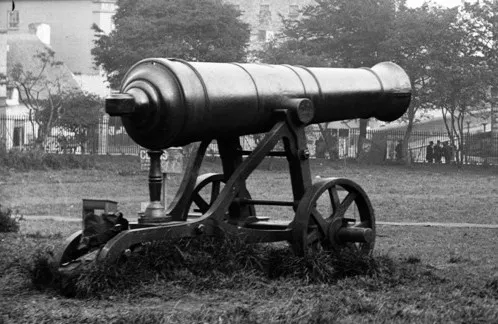
(Galway City Museum Photo)
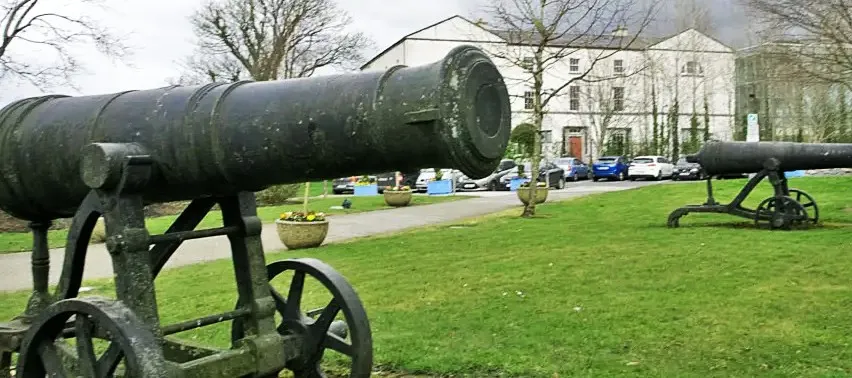
(Galway City Photo)
Russian Cast Iron 24-pounder Smoothbore Muzzleloading cannon, a trophy captured in the Crimean War (1853-1856) Trophy mounted on an iron garrison gun carriage, No. 1 of 2 in a downtown park. In 1857, the British Government’s War Department gifted two Russian cannon to Galway for its loyalty and support during the Crimean War (1853-56). The cannon were reputedly captured at the Battle of Inkerman in 1854, during which a significant amount of Russian ordnance fell into the hands of the 88th Regiment of Foot, later the Connaught Rangers. Now on display at City Hall on College Road.
Russian Cast Iron 24-pounder Smoothbore Muzzleloading Gun, Crimean War Trophy mounted on an iron garrison gun carriage, No. 2 of 2 in a downtown park.
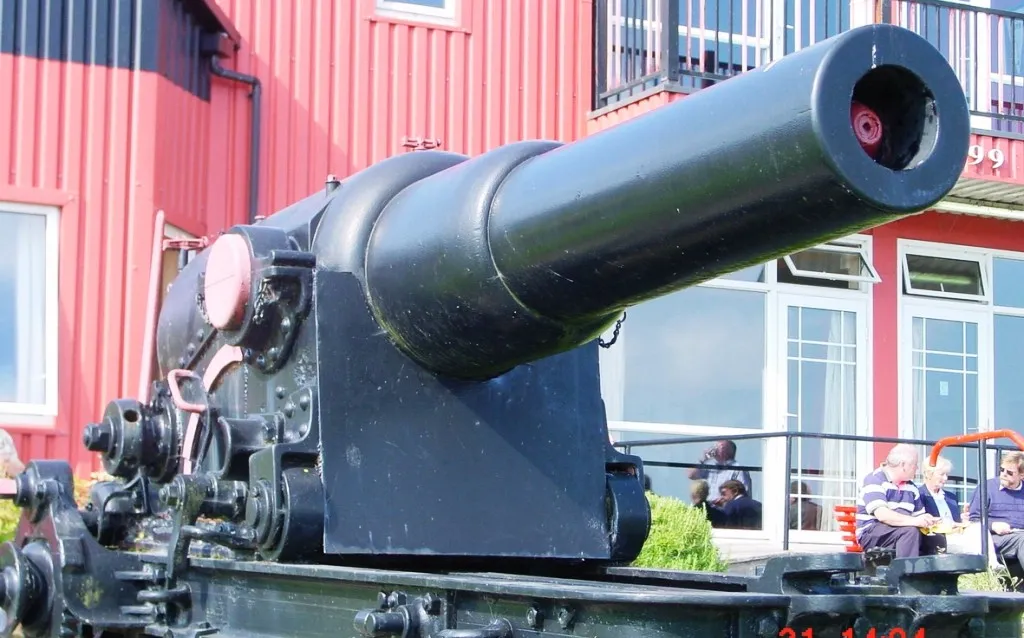
(Edward Bourke Photo)

(Lough Corrib Photo)
Two 64-pounders (RML’s) rifled muzzle-loaders (weight 64 cwt). Their ballistic performance: charge 8lb RLG powder, projectile, 64lbs muzzle velocity 1252 fps. Maximum range two miles. These guns were designed and constructed by the Royal Navy as Coastal Defensive guns from 1864. They were in the Mk. I to Mk. IV range and they are possibly the only survivors, of their class, in Great Britain and Ireland. These guns were positioned at the Battaries in Fairhill, Claddagh looking towards Mutton Island and under the command of the Naval Reserve (Artillery Militia) at Renmore Barracks. In 1881 Renmore became the training depot of The Connaught Rangers.
The Corrib Rowing and Yachting Club (CRYC), founded in 1864 is recognised as one of the oldest clubs in Ireland. The RMLs are located on Earl’s Island, Distillery Road, Galway. The gentlemen members of The Corrib Rowing and Yachting Club purchased them on 30 April 1906 as an ornamentation for the grounds of the Club.





